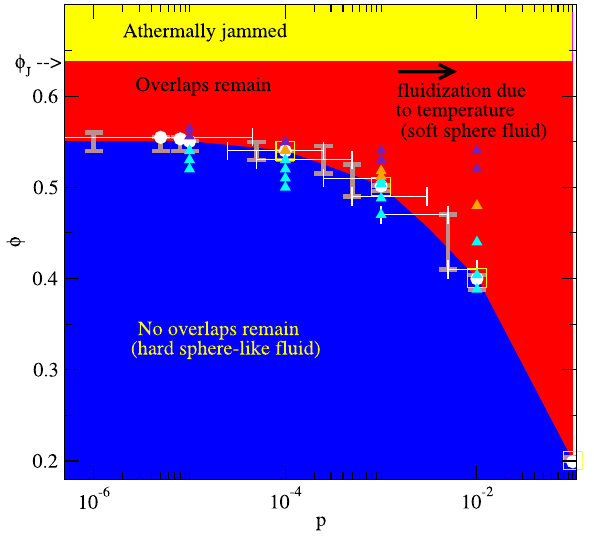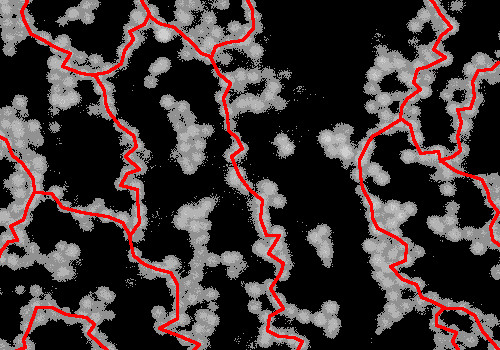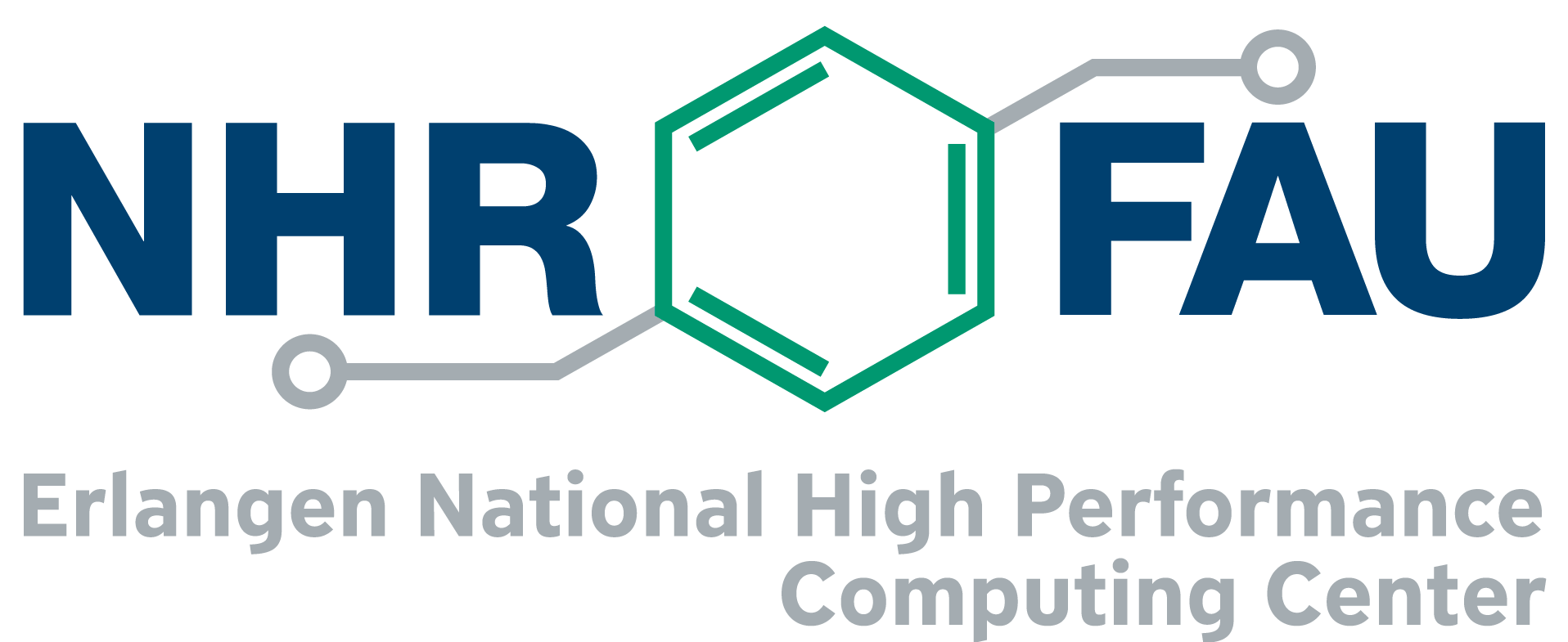HPC User Report from M. Maiti (Inst. Theoretische Physik 1)
Simulation of the glassy dynamics of soft spheres and colloidal gels
In many particulate systems a dramatic slowdown of the dynamics can be observed upon an increase of the packing fraction or a decrease of the temperature. The systems where such a slowdown of dynamics can be observed are manifold and usually the subject of very different research fields. For example, molecular liquids, colloidal suspensions, or emulsions might form glasses or gels at large densities, polymers during the folding process can end up in frustrated states, electrons in a metal might be almost localized, too many pedestrians can lead to dangerous congestions, and too many cars on a street cause a traffic jam. Though many of these phenomena are already known for a long time, the mechanism leading to the breakdown of dynamics still is the subject of ongoing research.
Motivation and problem definition
In our research project we consider a simple model system system of soft spheres that repel each other if they overlap but otherwise do not interact at all. Our goal is to reveal the mechanisms that are associated with the slowdown of dynamics at high densities and low temperatures.
Methods and codes

In order to study glassy dynamics at non-zero temperature, we introduce some random steps in order to resemble the effects of random thermal motion. Therefore, in our approach we employ a protocol that is composed of minimization towards a local minimum as known from studies on athermal jamming and steps where energy barriers can be crossed.
Results
We find a transition packing fraction above which the system can no longer reach the ground states and therefore is effectively non-ergodic. Interestingly, for small but non-zero probabilities to cross energy barriers (corresponding to small but non-zero temperatures) this transition packing fraction does not depend on the probability and is much smaller than the transition density of athermal jamming. The state diagram of thermally jammed and unjammed states as a function of the packing fraction and the probability to cross energy barriers is shown in the figure.
Furthermore, we can analyze the critical behavior of the glass transition, which has turned out to be the same as for a random organization or a directed percolation transition. Note that this critical behavior of a system at small but non-zero temperature therefore is fundamentally different from a system at zero temperature.
Our interpretation of the glass transition as a function of density and at small temperatures is as follows: While at small densities rearrangements can occur locally and the subsequent relaxation usually is fast, above the glass transition density rearrangements might affect the whole system and might occur on a timescale that is (directed) percolated in time. To strengthen our interpretation, we also study the percolation in space as well as the relaxation of a system after an enforced rearrangement event.
Our main results are published in [1] and our protocol is based on the ideas stated in [2].
Related systems
While so far, we have mainly studied monodisperse spheres in 3D, we now also explore the glass transition of a bidisperse system in 2D, of ellipsoidal particles in 3D, as well as of active particles.

Conclusions
In our project we employ a new approach to study the glass transition as a function of density. We can analyze the critical behavior and can make predictions on how the glass transition density depends on temperature. While many other approaches try to study glassy systems in quasi-equilibrium, it is possible with our approach to directly explore the glass transition in full non-equilibrium, i.e., in the way how it usually occurs in nature.
Outreach
We received financial support by the DFG (Grants SCHM 2657/2-1 and SCHM 2657/3-1).
- M Maiti, M. Schmiedeberg: The thermal jamming transition of soft harmonic disks in two dimensions, Eur. Phys. J. E (2019) 42: 38, DOI:10.1140/epje/i2019-11802-3
- M Maiti, M. Schmiedeberg: Temperature dependence of the transition packing fraction of thermal jamming in a harmonic soft sphere system, J. Phys.: Condens. Matter 31 (2019) 165101, DOI:10.1088/1361-648X/ab01e9
References
[1] M. Maiti and M. Schmiedeberg, Ergodicity breaking transition in a glassy soft sphere system at small but non-zero temperatures, Scientific Reports 8, 1837 (2018).
[2] L. Milz and M. Schmiedeberg, Connecting the Random Organization Transition and Jamming within a unifying model system, Phys. Rev. E 88, 062133 (2013).
[3] M. Kohl, R.F. Capellmann, M. Laurati, S.U. Egelhaaf, and M. Schmiedeberg, Directed percolation identified as equilibrium pre-transition towards non-equilibrium arrested gel states, Nature Communications 7, 11817 (2016).
[4] M. Kohl and M. Schmiedeberg, Shear-induced slab-like domains in a directed percolated colloidal gel, Eur. Phys. J. E 40, 71 (2017).
Researcher’s Bio and Affiliation
Michael Schmiedeberg studied physics in Konstanz, Kaiserslautern, and at the Yale University in New Haven (USA). For his PhD on the theory of soft colloidal quasicrystals he was in Konstanz, at the Max-Planck-Institute for Dynamics and Self-Organization in Göttingen, and at the TU Berlin where he finished his PhD in 2008. As a postdoc, he worked at the TU Berlin, the University of Pennsylvania in Philadelphia (USA), and at the Heinrich-Heine-Universität Düsseldorf where he was the principal investigator of an Emmy-Noether Junior Research Group. Besides soft colloidal quasicrystals, he is interested in colloidal structures on substrates, glassy dynamics, jamming, anomalous diffusion, and the motility of bacteria. Since fall 2015 Michael Schmiedeberg is professor of theoretical physics at the Friedrich Alexander University in Erlangen.
Moumita Maiti was a Postdoc in the group of Prof. Michael Schmiedeberg from 2015 to 2017. She completed her PhD in 2012 in India and has worked as a postdoc in Germany since 2013. At the moment she is a postdoc at the University of Münster.
